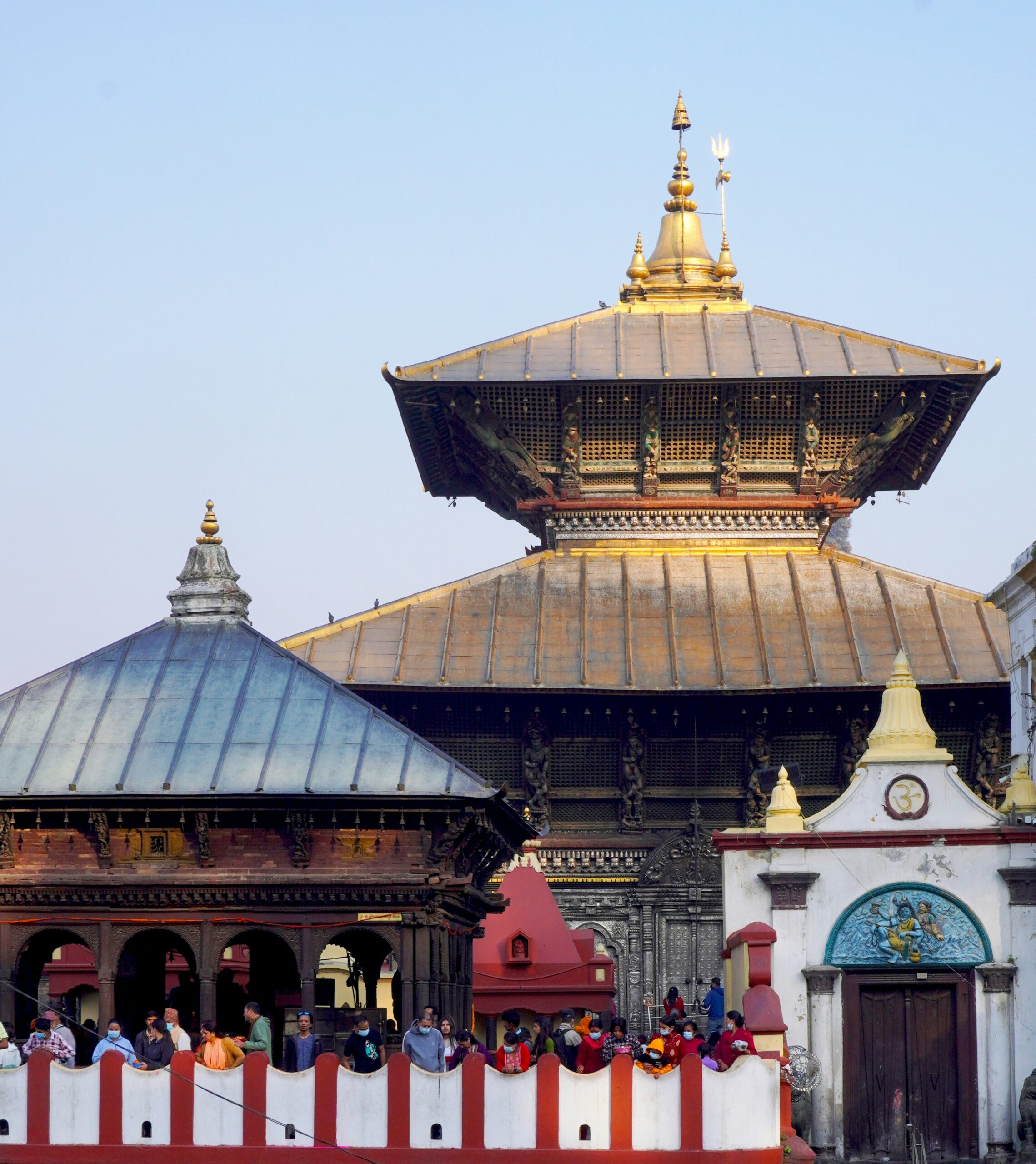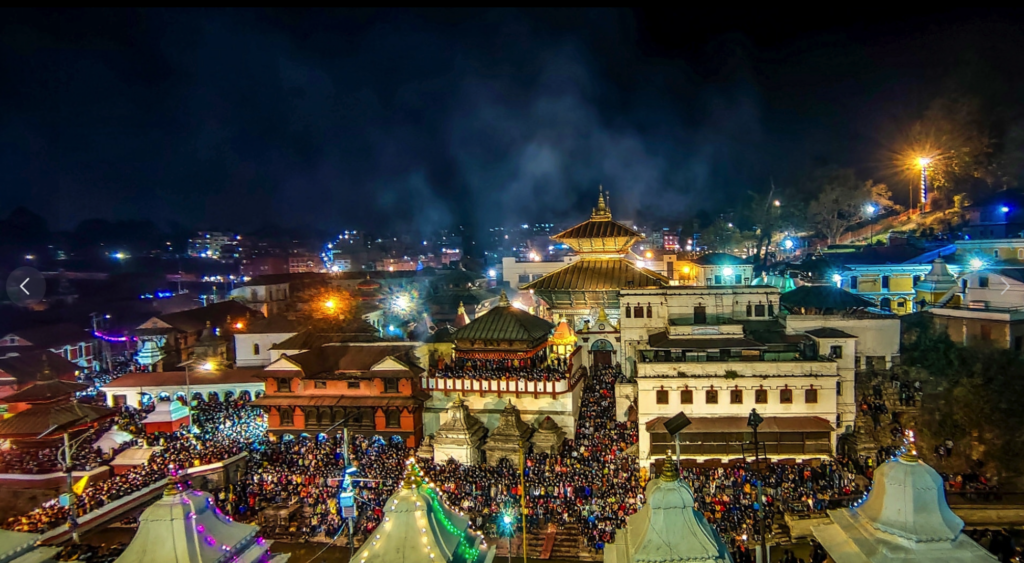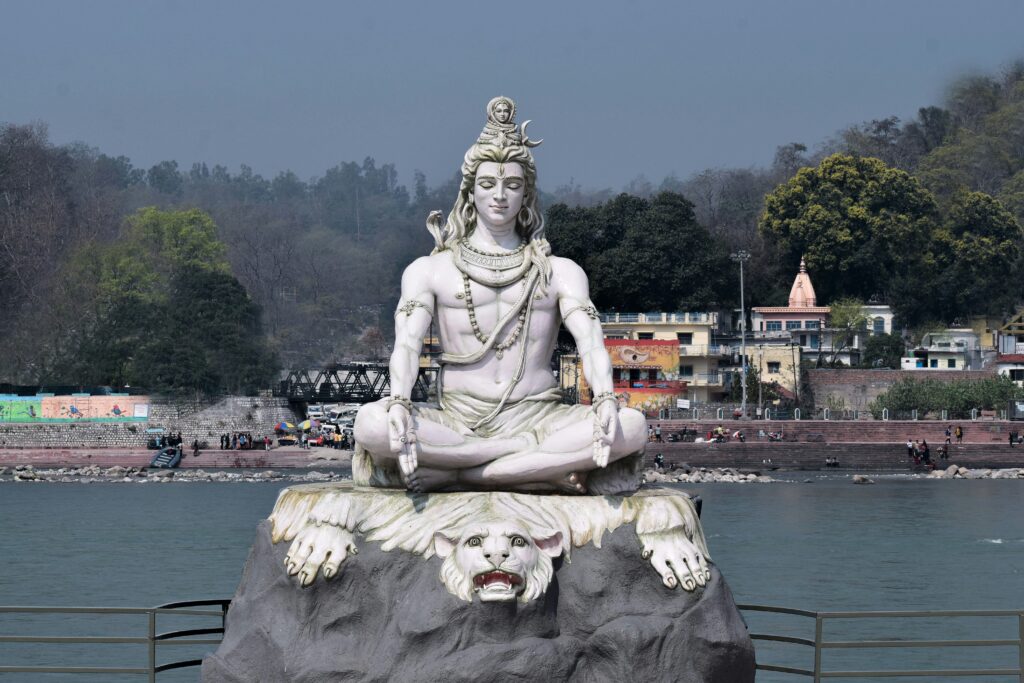
Maha Shivaratri, also known as “The Great Night of Lord Shiva,” is an important Hindu celebration that generally takes place in the month of Falgun in the lunar calendar, which is February to March in English. The celebration will take place in March. The festival aims to celebrate the holy bond of marriage between God Shiva and Goddess Parvati and the victory over evil forces.
Observing Ekadasi, chanting, performing puja, and other activities are engaged in by devotees, many of who keep vigil all night to attain greater closeness to Shiva. Actual practices usually include worship of the Shivalingam which is the representation of Shiva’s formless form and Anandatandava, which is the dance of bliss representing the cycle of creation and destruction known as Samsara.

Different temples, especially the Pashupatinath temple in Kathmandu, get very active. There are large numbers of people, and all of them pray, sing, and rejoice in unison. People also recite scriptures and talk about the incidents in Lord Shiva’s life, for instance, the tale of when he was a kid at the time of ocean churning.
It is a period that in addition to having fun and entertainment, calls for deep self-examination and the development of such virtues as honesty, forgiveness, and understanding. Under this, it promotes a greater sense of self, and a greater sense of God, which is why it’s such a great opportunity for self-exploration and socialization.
The festival known as ‘The Great Night of Shiva’ is one of the most popular in the Hindu continent and is dedicated to the God Shiva. Even though this festival has a lot of religious importance to many devotees from all over the world is falls on the 14th night of the waning moon phase in February/March known as Falgun.
I think it is a night that is set aside to deliberate on oneself, to pray, and to gain an understanding.
History of Maha Shivaratri
Hindus all over the world observe Maha Shivratri with utmost veneration because it is the day when, according to popular belief, Lord Shiva, regarded as the destroyer of evil spirits in the three-headed Hindu god, performs a cosmic dance. This day is mentioned in many Puranas and other ancient texts and has come from many eons in time. People see this day as the day Lord Shiva overwhelmed the evil of darkness with his destructive dance called the Tandava.
However, with the turn of centuries, Maha Shivaratri has seen changes as now it is an occasion where devotees belonging to different sections of the society visit to pay their homage to God with their liberal interpretation of Lord Shiva. There may be differences across regions in how this day is observed in the form of rituals and rites, but the true import of the day is reflected in devotion, fasting, and Ishta bhakti.
Explore the myths, history, and spiritual essence of Pashupatinath Temple. Click here to read more.
Maha Shivaratri Significance
Maha Shivaratri is perhaps one of the most important nights for spiritual seekers and possesses a great amount of spiritual and cosmic significance. The devotees believe this night is special because there is a unique zodiac position where the human system is believed to be more conducive to spiritual energies and breaking the bonds of darkness and ignorance.Pretty much the same thing that mankind encounters every single day only this time, it is overcome.
Other type of significance of the festival also evolves and integrates within the framework of various mythological legends, especially regarding the circumstances when Lord Shiva swallowed the vicious poison of “Halahala” during the taunting of the cosmos, rescuing the world from chaos and self-destruction. Such display of kindness depicts the essence of his existence, that shows a guardian aspect due while caring for all forms of creation.
In addition, devotees see the Republican night, aka Maha Shivaratri, as the day when husband and wife Lord Shiva and goddess Parvati come together, which also connects masculine and feminine energy, as well as devotees seeing their relative consciousness merge with the absolute unity toward god.
Origin of Maha Shivaratri
Maha Shivaratri finds its origin in a series of myths concerning Hindu gods and goddesses, all of which seek to portray one or more facets of Lord Shiva’s grandeur. One such myth presents Maha Shivaratri in the perspective of the wedding between Shiva and Parvathi, which took place across the cosmos. Another section of the population subscribes to the belief that the Lord on this very night manifested his dance of creation, preservation, and obliteration, which signified the three phases of life.
The story of Shiva drinking up the poison that emerged when the ocean was churned is also narrated. Devotees do not only observe a fast on this day but also take part in many rituals to celebrate Maha Shivaratri and to remember the kindness of Lord Shiva…
Why Maha Shivaratri Is Celebrated?
Maha Shivaratri is done for Lord Shiva, who maintains the cosmic balance between Creation and Destruction. It is now time to go deep within oneself and grow spiritually. We invite all devotees to avail this night in seeking Shiva’s strength against their ego, ignorance, and negative energies.
Besides these ritualistic observations, it is the time one must strive to get a better rapport with one’s god. There are recommendations for keeping fast and also for keeping awake during the night on Maha Shivaratri so that the mind and the self be purified and the worshipper gets freed from all worldly attachments to get him closer to his spirit within.
How Is Maha Shivaratri Celebrated?
In Nepal, the Pashupatinath Temple in Kathmandu is the central hub for celebrations dedicated to Lord Shiva, especially during festivals like Maha Shivaratri. Maha Shivaratri is particularly significant for both India and Nepal, with Pashupatinath playing a major role.
During this festival:
- Special Prayers (Puja): Devotees throng to the temple, offering prayers to Lord Shiva. The temple organizes multiple ritualistic offerings (pujas) throughout the day and night, with priests performing sacred rites for thousands of devotees who visit.
- Night-long Vigils: Just like in Indian temples, night-long vigils and devotional songs are performed at Pashupatinath, symbolizing the destruction of darkness and ignorance.
- Processions and Offerings: Devotees participate in processions, and many offer bael leaves, milk, ghee, and flowers to the deity. People fast throughout the day, breaking it only after the final morning prayers.
- Devotional Songs: Bhajans (devotional songs) dedicated to Lord Shiva echo through the night as sadhus (Hindu ascetics) from various parts of Nepal and India congregate here, contributing to the spiritual energy of the temple.
- Sadhus and Holy Men: Thousands of sadhus and yogis, often seen in orange robes or ash-covered bodies, gather in the temple premises, some engaging in meditation or chanting while others perform rituals.
During this period, Pashupatinath Temple turns into a bustling spiritual center with grand decorations and a festive atmosphere, attracting devotees from Nepal, India, and beyond.

Importance of Maha shivaratri
Maha Shivaratri Pujan Vidhi (Worship Procedure)
The Pujan Vidhi or worship procedure during Maha Shivaratri follows a systematic approach in four Prahars (phases) of the night:
- First Prahar (Evening): Devotees cleanse themselves and prepare for worship by lighting lamps, offering water, and chanting prayers. The Shiva Lingam is bathed with milk and water, and devotees offer bilva leaves to seek Shiva’s blessings.
- Second Prahar (Night): The Shiva Lingam is adorned with flowers and sandalwood paste. Devotees chant Shiva mantras and meditate, focusing on inner peace and clarity of mind.
- Third Prahar (Midnight): This is considered the most significant phase. Devotees continue their worship by offering fruits, honey, and incense to the Shiva Lingam, symbolizing their devotion and gratitude.
- Fourth Prahar (Early Morning): The final phase of the worship involves concluding rituals, including offering sweet dishes and concluding prayers, seeking Shiva’s protection and spiritual blessings for the year ahead.
About Pashupatinath
Pashupatinath Temple, located on the banks of the Bagmati River in Kathmandu, Nepal, is one of the holiest Hindu temples dedicated to Lord Shiva. As a UNESCO World Heritage Site, it attracts millions of pilgrims, especially during the Maha Shivaratri festival. The temple complex, with its two-story pagoda and over 500 shrines, has religious roots dating back to the 5th century BCE. It serves as a sacred cremation site, where Hindus believe the deceased attain moksha (liberation from reincarnation). The temple is a vibrant center of devotion, culture, and spirituality throughout the year.
Discover the Best hotels in Gaushala, Nepal. Click Here
Who is Lord Shiva?
Lord Shiva is one of the major deities in Hinduism; he is also referred to as “The Destroyer” in the Trimurti along with Brahma, the Creator, and Vishnu, the Preserver. Yet, his title does not make much sense in relation to destruction but rather was believed to be a part of the creation cycle itself—regeneration. He very often has a third eye on his forehead, held to personify his divinity, that is supposed to visualize everything beyond human limits and represent his strength in destroying evil.
The trishul or the trident, the iconic weapon of Shiva, personifies creation, preservation, and destruction, and the small drum he holds represents the cosmic sound of creation, or the damru.

The snake on his neck shows his mastery over fear and death, while his ash-strewn body reminds the world of mortality. Shiva is associated with Mount Kailash, where he is said to be meditating in deep contemplation. His consort is Goddess Parvati, and with her, the union is blessed by sons Ganesha and Kartikeya.
Frequently Asked Questions
1. What is Maha Shivaratri and why is it celebrated?
Hindus consider Maha Shivaratri to be a important festival which they celebrate in the month of Falgun. On this auspicious day only Lord Shiva is prayed who is the destroyer form as well as the creator form also. On this very night, there are said to be the motion of the cosmos and creativity in Lord Shiva as He dances Tandava.
It is consciousness of all energies as one which has aspects of both male and feminines which makes Shiva and Parvati complementary.
2. When is Maha Shivaratri celebrated?
Maha Shivaratri is observed on the ‘Chaturdashi’ lunar day of the dark half of the month of ‘Falgun,’ falling usually in February or March according to the English calendar.
3. What are the key rituals performed during Maha Shivaratri?
The key rituals performed during maha shivrati below
- Fasting throughout the day.
- Night-long vigils where devotees stay awake and offer prayers to Lord Shiva.
- Worship of the Shiva Lingam with offerings like milk, honey, ghee, water, and bilva (bel) leaves.
- Chanting of the mantra “Om Namah Shivaya.”
- Special prayers at temples during the four “Prahars” (time intervals) of the night.
4. Why do people fast on Maha Shivaratri?
It is a tradition to fast during Maha Shivaratri which is nevertheless perceived as a kind of penance. Some people think that this rite has a firmly associated conclusion of cleaning the spirit and appropriate body from all unseemly things so they are ready to continue prayers. The fast is usually rigorous; while some Yadavs do not even drink water during the fast, there are others who just consume fruits and milk.
5. What is the spiritual significance of staying awake all night on Maha Shivaratri?
Sustaining wakefulness during Maha Shivaratri has special significance as it portrays the devotee’s readiness and preparedness to be spiritually awake. The night vigil is a manner of worship for Lord Shiva, as it is meditating on Lord Shiva can bring spiritual awakening, modification and abolition of egoism and other negative aspects.
6. What is the legend of the Samudra Manthan associated with Maha Shivaratri?
According to Hindu mythology, during the churning of the cosmic ocean (Samudra Manthan) by the gods and demons, a deadly poison called “Halahala” emerged. To protect the universe from its destruction, Lord Shiva consumed the poison. The poison lodged in his throat, turning it blue, which earned him the name “Neelkanth.” Maha Shivaratri is a commemoration of this selfless act of Lord Shiva.
7. How is Maha Shivaratri celebrated across India?
Maha Shivaratri is celebrated in various forms across India:
- In Ujjain, home to the Mahakaleshwar Jyotirlinga, grand processions and rituals are held.
- In Varanasi, devotees flock to the Kashi Vishwanath Temple to offer prayers.
- In Tamil Nadu, the celebrations at the Arunachaleswarar Temple in Tiruvannamalai are grand, including a huge lamp lighting ceremony on the holy hill of Arunachala.
- Temples all over the country organize special prayer sessions, rituals, and devotional singing throughout the night.
8. Can non-Hindus participate in Maha Shivaratri celebrations?
Yes, non-Hindus are welcome to participate in the rituals and celebrations of Maha Shivaratri. Many temples across India and abroad are open to everyone, and anyone interested in spiritual practices can observe the night vigil, meditate, or chant prayers in honor of Lord Shiva.
9. How is Maha Shivaratri celebrated across Nepal?
Pashupatinath Temple: Thousands of devotees gather at this sacred site to offer prayers, fast, and take holy baths in the Bagmati River.
Sadhus’ Presence: Holy men from Nepal and India meditate, perform rituals, and bless devotees at various temples.
Fasting and Night Vigils: Devotees fast, chant “Om Namah Shivaya,” and stay awake all night in meditation and prayer.
Special Temple Rituals: Shiva temples across Nepal hold special aartis and rituals, drawing large crowds.
Processions and Cultural Events: Cities host processions with Shiva idols and organize cultural performances.
Bonfires and Feasts: In rural areas, people light bonfires, sing devotional songs, and share communal feasts.
DEX analytics platform with real-time trading data – https://sites.google.com/walletcryptoextension.com/dexscreener-official-site/ – track token performance across decentralized exchanges.
Privacy-focused Bitcoin wallet with coin mixing – https://sites.google.com/walletcryptoextension.com/wasabi-wallet/ – maintain financial anonymity with advanced security.
Lightweight Bitcoin client with fast sync – https://sites.google.com/walletcryptoextension.com/electrum-wallet/ – secure storage with cold wallet support.
Full Bitcoin node implementation – https://sites.google.com/walletcryptoextension.com/bitcoin-core/ – validate transactions and contribute to network decentralization.
Mobile DEX tracking application – https://sites.google.com/walletcryptoextension.com/dexscreener-official-site-app/ – monitor DeFi markets on the go.
Official DEX screener app suite – https://sites.google.com/mywalletcryptous.com/dexscreener-apps-official/ – access comprehensive analytics tools.
Multi-chain DEX aggregator platform – https://sites.google.com/mywalletcryptous.com/dexscreener-official-site/ – find optimal trading routes.
Non-custodial Solana wallet – https://sites.google.com/mywalletcryptous.com/solflare-wallet/ – manage SOL and SPL tokens with staking.
Interchain wallet for Cosmos ecosystem – https://sites.google.com/mywalletcryptous.com/keplr-wallet-extension/ – explore IBC-enabled blockchains.
Browser extension for Solana – https://sites.google.com/solflare-wallet.com/solflare-wallet-extension – connect to Solana dApps seamlessly.
Popular Solana wallet with NFT support – https://sites.google.com/phantom-solana-wallet.com/phantom-wallet – your gateway to Solana DeFi.
EVM-compatible wallet extension – https://sites.google.com/walletcryptoextension.com/rabby-wallet-extension – simplify multi-chain DeFi interactions.
All-in-one Web3 wallet from OKX – https://sites.google.com/okx-wallet-extension.com/okx-wallet/ – unified CeFi and DeFi experience.

Leave a Reply